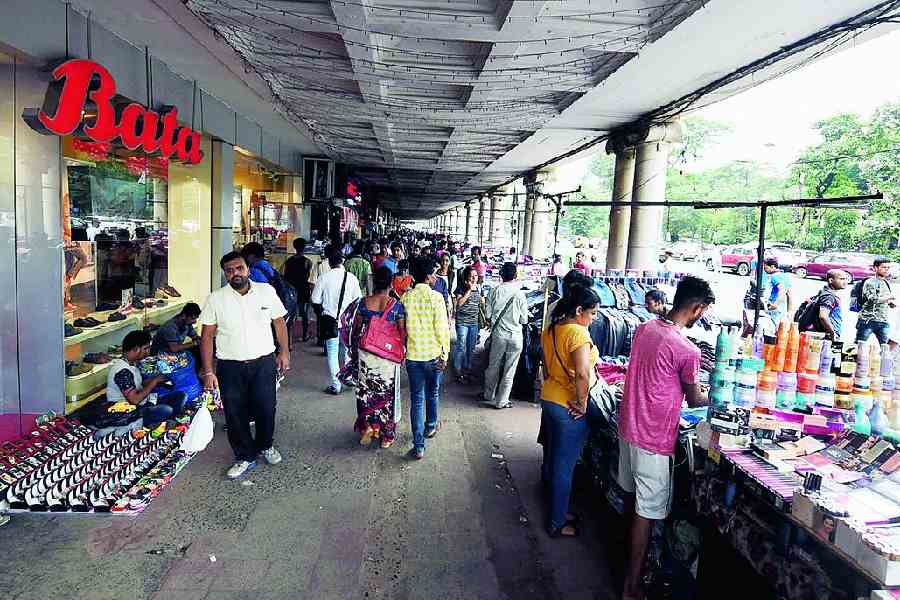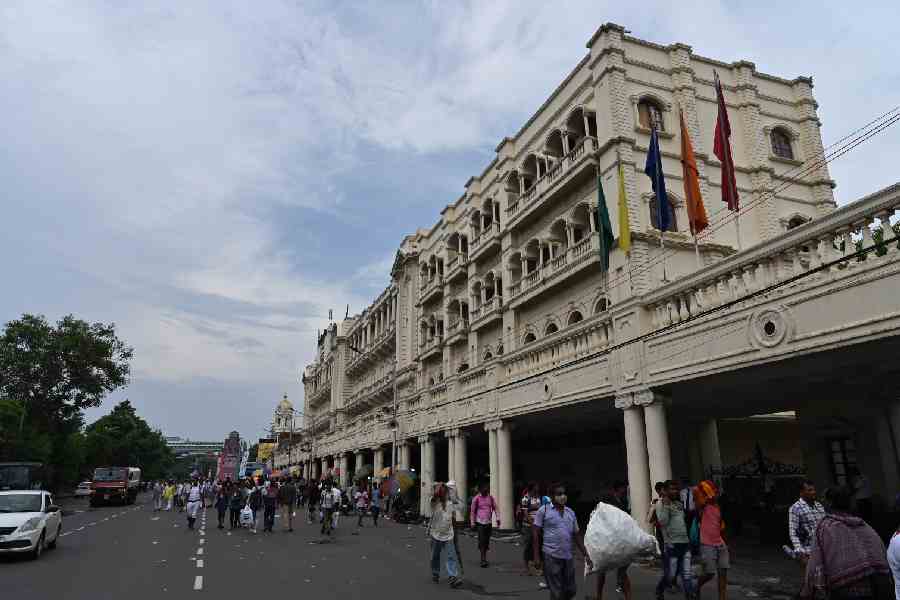Pulling up the Calcutta Municipal Corporation for its alleged “inaction”, the Calcutta High Court has stepped in to do its bit in restoring the lost glory of the Oberoi Grand Arcade, a British-era landmark in the heart of Chowringhee in central Calcutta, and remove encroachers from the heritage site.
In an interim order passed by Justice Amrita Sinha on Friday, one that could have far-reaching implications in clearing the Arcade overrun by hawkers and vendors, most of whom illegally occupy the pavement, the court directed the corporation “to file a report with regard to the steps taken to keep the pavement free for pedestrians.”
“The report of the Corporation shall mention as to whether any licence has been issued in favour of any of the hawkers to sell goods and or articles in the pavement. Names and addresses of the hawkers/vendors in front of the subject premises shall be disclosed in the report to be filed by the Corporation,” the order stated.
The court asked for the report to be presented on or before the next date of hearing fixed on October 5.

A police inquiry found that 'hawkers have encroached a portion of the footpath hindering pedestrian movement except the entrance and exit gate.' The Telegraph Online.
The directions were passed with regard to a writ petition filed by the Oberoi Group of Hotels who moved court after their back-to-back representations before the city civic body to remove the illegal encroachers allegedly fell on deaf ears.
Interestingly, the court also slapped an embargo on the CMC on granting fresh licenses to the hawkers operating in the Arcade area after the Hotel expressed its apprehension that the civic body may resort to a hostile move and regularise hawkers’ presence on the sidewalk. “No further license shall be issued by the Corporation without leave of the Court,” the order stated.
Taking cognizance of the petitioner’s plea that the hawkers were illegally sourcing electricity for their stalls from exposed street light wirings, the court further directed the Calcutta Electric Supply Corporation (CESC) to state in a report “whether any electricity connection has been given on the pavement of the subject structure.”
The court also granted leave to the petitioner to add CESC as party respondents to the case.
Respondents to the petition, both the CMC as well as the New Market police station, under whose jurisdiction the Grand Hotel Arcade falls, conceded to the fact that nearly all occupants of the hotel’s portico were operating without a mandatory trade license.
In a report filed before the court, OC, New Market PS stated that a police inquiry found that “hawkers have encroached a portion of the footpath hindering pedestrian movement except the entrance and exit gate.”
“The police is trying its best to keep the entry and exit to the hotel free of hawker encroachment,” the counsel appearing for the New Market PS stated during the course of the hearing which attracted the judge’s dismay. “What about the facade? Why will a heritage building façade not be viewed? What do mean when you say ‘trying their best’? How are they trying?” Justice Sinha made no attempts to hide her irritation.
Police, however, submitted in court that it was ready to act in accordance with any directions passed by the court. “Why can’t you act on a suo motu basis? Why do the authorities need a court order to act?” the judge asked during the course of the hearing.
“The Oberoi Grand is a CMC-declared Grade I heritage structure and as such its façade should be conspicuously viewable without any kind of obstruction,” said Rachit Lakhmani, counsel for the Oberoi Group. “But here is a situation where vendors have set up semi-permanent structures on the pavement which has not only choked pedestrian movement but has also perpetrated a safety hazard to the property by stealing power sourced from street lights by means of hooking,” added Lakhmani, who was assisted by advocates on-record Emon Bhattacharya and Pooja Sah.
“The ground floor abutting the property is full of shops which are among the top brands in the city. The owners of these outlets are tenants of the hotel. Among other factors, the hawkers have also effectively obstructed the footfall in these stores and infringed upon their right to ingress and egress,” Lakhmani pointed out.
Referring to the Bagri Market fire in September 2018 which gutted almost the entire market complex, the lawyer cast serious apprehensions on a similar disaster waiting to happen on the Arcade where an entire illegal market has been raised encroaching on a sidewalk. “The rooms on the first floor of the hotel are barely a few meters up and imagine the hazard it means to their occupants,” he stated.
Over the last few decades, both police and CMC authorities have been struggling to keep the proliferation of illegal hawkers under check in the Arcade and the adjacent New Market area. “After every raid, the hawkers temporarily scoot but eventually find their way back and gobble up the space. The joy of finding a hawker-free Grand Arcade is always short-lived,” a shop owner in the Arcade, while sharing his experiences of getting smothered by the hawkers on a daily basis, said.
Ironically, a sharp contrast to this situation can be found at The Taj Mahal Hotel in Colaba, Mumbai, yet another heritage property sporting a similar arcade but one remaining free of illegal encroachment.
At the 2018 annual general meeting of the East India Hotels, the company that owns the Oberoi hotel chain, its executive chairman Prithvi Raj Singh Oberoi expressed serious displeasure over the condition of the Arcade. “If you want to buy something from the Grand Arcade, you can’t go there. The shopkeepers are crying,” Oberoi had said in his address to shareholders.
“This is an ever-growing menace in the area. Their numbers are perpetually on the rise with every passing day,” Lakhmani maintained, “We were forced to move court after some six to seven representations we made before the CMC were responded to only by friendly assurances but no effective counter steps.”











